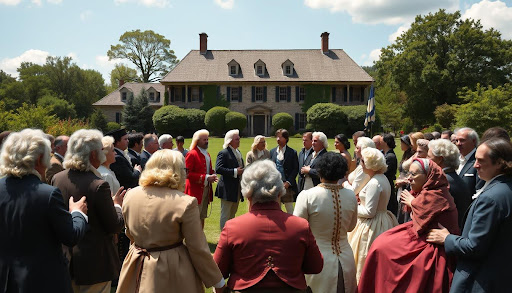When did the political divide start
The roots of America’s political divide go back to the nation’s start. From the Founding Fathers to today, the country has faced many ideological battles. This article looks at the beginnings of this divide, focusing on key events and forces that widened the gap between the left and right.
Key Takeaways
- The political divide in America started with the nation’s founding. The Founding Fathers had different visions for the country’s future.
- The rise of political parties, like the Federalists and Democratic-Republicans, made these differences more clear.
- The Civil War was a turning point that made the divide deeper. Issues like slavery and states’ rights were at the heart of the conflict.
- In the 20th century, social and cultural movements, such as the civil rights movement and the culture wars, shaped the country’s politics.
- Today, the political divide is very strong. Partisan gridlock and political tribalism keep the tensions high.
Exploring the Origins of America’s Political Polarization
The roots of political polarization in the United States go back to the nation’s early days. Even the founding fathers had ideological differences. These differences helped create the two-party system we see today.
Early Signs of Ideological Differences
The American Revolution and the ratification of the Constitution were key historical events. They showed different visions for the country’s future. Leaders like Alexander Hamilton and Thomas Jefferson had very different views on government and state power.
These ideological differences grew bigger because of economic and geographic divides. The North and South disagreed on slavery and tariffs.
The Impact of Key Historical Events
As the young nation faced these challenges, important historical events like the War of 1812 and the Missouri Compromise made things worse. The growing tensions between the Federalists and Democratic-Republicans set the stage for future conflicts.
The founding fathers‘ failure to agree on their ideological differences led to long-lasting political conflicts. These conflicts shaped America’s political landscape for many years.
“The seeds of today’s political polarization were sown in the earliest days of the republic.”
The Founding Fathers and Political Divisions
The founding fathers of the United States had different views on government and the Constitution. These views created the political divisions that shaped the country’s future. They all wanted independence, but disagreed on many things.
The Federalists, led by Alexander Hamilton, wanted a strong central government. They believed it should control commerce and finance. On the other hand, the Democratic-Republicans, led by Thomas Jefferson and James Madison, wanted a government that gave more power to states. They wanted to protect individual rights.
“The Constitution is not an instrument for the government to restrain the people, it is an instrument for the people to restrain the government – lest it come to dominate our lives and interests.” – Patrick Henry
The debates of the founding fathers about the Constitution and government set the stage for ongoing political divisions. Their different visions helped create the two-party system in the early Republic.
The founding fathers‘ views on the Constitution and government still influence today’s political divisions. Their decisions and ongoing debates show the lasting impact on American democracy.
The Rise of Political Parties: Federalists vs. Democratic-Republicans
When the United States was new, two parties emerged: the Federalists and the Democratic-Republicans. They had different ideas for the country’s future. This rivalry started the two-party system we see in American politics today.
Contrasting Visions for the Nation
The Federalists, led by Alexander Hamilton, wanted a strong central government and a national bank. They also wanted to keep close ties with Britain. On the other hand, the Democratic-Republicans, led by Thomas Jefferson, believed in a smaller government and more power for states. They wanted a country based on farming and individual freedom.
The battle between these two parties was intense. Each side tried to influence the country’s path. Their disagreements and competition for power created the modern two-party system we know today.
| Federalists | Democratic-Republicans |
| Supported a strong central government | Favored a decentralized government with states’ rights |
| Advocated for a national banking system | Opposed a national banking system |
| Aligned with Britain | Aligned with France |
| Believed in a more industrialized, financially driven America | Envisioned an agrarian, community-based nation |
The rivalry between the Federalists and Democratic-Republicans shaped the early years of the United States. It also set the stage for the political parties, two-party system, and political ideologies that shape American politics today.
The Civil War: A Defining Moment for America’s Divide
The American Civil War was a key event that deepened the political divide in the United States. It was sparked by two main issues: slavery and states’ rights versus federal power.
Slavery and States’ Rights Fueled the Conflict
The Northern states wanted to end slavery, driven by an abolitionist movement. On the other hand, the Southern states, which depended on slavery, fought to keep it. This disagreement over slavery’s morality and legality was complicated by the debate on states’ rights.
The South wanted more freedom and autonomy, while the North believed in a stronger federal government. This disagreement led to the start of the Civil War in 1861. The war lasted four years, ending with the Union’s victory and the end of slavery. Yet, the divide between the North and South continued to affect the country’s politics for many years.
The Civil War left a nation deeply divided, with its impact still felt in American politics today. The issues of slavery and states’ rights that caused the war have evolved. However, the tension between different visions for the country’s future remains a key part of American politics.
When did the political divide start?
The political divide in America began at the country’s founding. It stems from historical events and different beliefs. These early differences set the stage for today’s political divide.
The ratification of the U.S. Constitution was a key moment. The Founding Fathers had different views on government power. This led to the Federalist and Democratic-Republican parties, each with its own beliefs.
The Civil War made the divide worse. It was about slavery and states’ rights. After the war, the Republican and Democratic parties grew, shaping politics for years.
In the 20th century, the divide grew. Movements like the Civil Rights Movement and the Vietnam War caused big debates. Media and new tech also made the divide more visible.
Now, the political divide is stronger than ever. The two main parties often can’t agree. Knowing how this divide started and grew is key to fixing it and creating a more united country.
The Polarization of the 20th Century
The 20th century saw a big increase in the political divide in America. Social and cultural movements had a big impact. The civil rights, feminist, and religious right movements were key. They made the country’s politics more divided.
The Role of Social and Cultural Movements
The civil rights movement of the 1950s and 1960s fought for racial equality. It sparked strong debates and opposition. The feminist movement, pushing for women’s rights, also faced resistance.
The rise of the religious right added to the divide. It stood for conservative values, opposing the progress of social movements. These changes made the political divide in America even deeper.
As people joined their causes, the lines between left and right grew clearer. The divide between liberals and conservatives became more fixed.
| Social Movement | Impact on Political Polarization |
| Civil Rights Movement | Sparked fierce debates and opposition from those resisting change |
| Feminist Movement | Met with resistance from those fearful of the upheaval of traditional gender roles |
| Rise of the Religious Right | Clashed with progressive ideals, further entrenching the ideological divide |
“The social and cultural movements of the 20th century served as catalysts for the deepening of the political divide in America, as individuals and groups rallied around their respective causes, solidifying the lines between left and right, liberal and conservative.”
Modern-Day Dynamics: Partisan Gridlock and Political Tribalism
In today’s politics, America’s long-standing divisions have grown worse. The rise of partisan gridlock makes it hard for lawmakers to work together. This is because the two-party system has become more polarized, with each side focusing on winning rather than solving problems.
Political tribalism has also become a big issue. People are more stuck in their beliefs, seeing those who disagree as enemies. This makes it hard to have real conversations, as both sides often ignore each other’s views.
The effects of these trends are huge. The country can’t tackle big issues like healthcare and education. Many feel let down by politics. The future of democracy is at risk, showing we need to work together and get more people involved in politics.
FAQ
When did the political divide start in America?
The political divide in America began with the nation’s founding. The Founding Fathers had different views on government and the Constitution. The Federalist and Democratic-Republican parties, which emerged later, made these differences clear. This laid the groundwork for today’s two-party system.
What were the early signs of ideological differences among the Founding Fathers?
Even as they worked together to create a new nation, the Founding Fathers had different ideas. Alexander Hamilton wanted a strong central government. Thomas Jefferson believed in states’ rights. These views showed the early signs of the political divide.
How did key historical events shape the political divide in America?
Key events like the American Revolution and the ratification of the Constitution helped form political factions. Debates over the Constitution and issues like slavery and states’ rights widened these differences. These factors led to the Civil War and continue to shape American politics today.
How did the Civil War exacerbate the political divide in America?
The Civil War made the political divide worse. It was fought over slavery and states’ rights. The conflict between the North and South left a lasting mark on American politics.
What role did social and cultural movements play in the 20th-century polarization?
The 20th century saw the political divide deepen. Movements like the civil rights and feminist movements, and the rise of the religious right, widened the gap. These movements made it harder to find common ground in politics.
What are the current dynamics of political polarization in America?
Today, America faces challenges like partisan gridlock and political tribalism. Ideological differences have become more entrenched. This makes finding bipartisan solutions to complex issues very difficult. The ongoing political divide has made these differences even more pronounced.







I first noticed the divide during a family dinner, where conversations turned heated, leaving us divided in views.
Doubt: Is the political divide in America solely rooted in ideology or are there other factors at play?
Author Reply: The political divide in America is complex, influenced by ideology, social issues, economics, and historical events.
Great insight into America’s political history, tracing the roots of the divisive climate from the Founding Fathers to present.
Doubt Comment: How can we be sure the origin of the political divide isn’t even further back in American history?
Author Reply: Historical debate exists, but scholarly consensus points to the nation’s founding era as pivotal.
Comment: “Interesting read! Could the Civil War era be considered a turning point in exacerbating the political division?”
Author Reply: “Great point! The Civil War indeed deepened the political divide with its stark North-South ideological differences.”